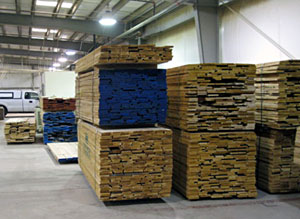Wood Species
.png)
Solid wood cabinets can last anywhere from 20-50 years, depending on the type of wood you choose. When shopping for new cabinet doors, you'll want to pick a wood type that can withstand everyday wear and tear and complement your aesthetic preferences.
Not sure which option to choose? We're here to help. Here's a list of the best types of wood for kitchen cabinets and some characteristics to consider before making the investment.
Characteristics to Consider When Shopping For The Best Wood for Kitchen Cabinets
Whether you're looking for replacement cabinet doors or completely renovating your kitchen or bathroom. There are various features you'll want to consider with cabinet wood types to ensure you find the perfect match for your project. This includes:
- Durability
We use the Janka Wood Hardness Scale to determine the hardness of a specific wood type. The harder the wood, the more resistant it is to scuffs, dents, and general wear and tear.
- Budget
The cost will vary depending on the type of wood you choose. Harder woods like cherry and hickory are more expensive than oak or paint-grade wood. Woods that are more scarce or easier to work with are also more expensive.
- Color and Grain Pattern
The best wood for kitchen cabinets features different grain patterns and colors. When deciding which is best for your project, you'll want to consider the overall design of your kitchen or bathroom.
Oak is lighter in color and features a fine-grain pattern, making it great for modern aesthetics. While cherry has a rich, darker appearance that complements traditional aesthetics.
- Paint vs. Clear Finish
Lastly, you'll want to know if you decide to paint the cabinet doors or add a clear finish to the natural wood. The best option for painting paint-grade wood. This type of wood is typically made out of MDF and has a smooth surface perfect for paint application.
If you want the natural color of the best wood for kitchen cabinets to be the focal point of your kitchen, you'll want to add a clear finish instead. A clear finish will add a shiny touch and protect your cabinet doors from wear and tear.
What is the Best Wood for Kitchen Cabinets?
Once you know what you're looking for in a wood type for your cabinet doors, it's time to start weighing the pros and cons.
Here are our top five picks for the best wood for kitchen cabinets.
Most Durable: Hickory
Hickory is one of the most durable wood types for kitchen cabinets on the market. It has a hardness rating of 1820. It's shock-resistant and has superior structural integrity. Hickory is also strong enough to withstand everyday wear and tear.

Knotty Hickory

Select Hickory
Pros
- Durability and versatility
- Natural warm hue with a varied grain pattern
- Ideal for high-traffic areas and cabinets that experience heavy use
Cons
- More expensive than other wood types
- Requires regular maintenance and upkeep to maintain the look
- Not the best for kitchens that require a uniform look
Most Expensive: Cherry
Cherry wood is one of the best types of wood for kitchen cabinets. The aesthetic appeal is charming and traditional. While cherry is only a 950 on the Janka Hardness Scale, it's still durable enough to last a few decades in your home. This wood type is resistant to general surface damage. The dark red hue is paired with a distinguished grain pattern. The natural red hue also gets darker with age, adding extra character to traditional or rustic kitchen designs.
Even though cherry tends to run on the more expensive side, it is a top choice if you're looking for dark-colored wood with distinctive grain patterns.

Select Cherry
Pros
- Elegant, rich color that deepens over time
- Durable and more resistant to everyday wear and tear
- Smooth and consistent grain pattern
Cons
- Consistent exposure to UV rays can change the natural hue of the wood
- More expensive than other options
- Not the most versatile option if you decide to change your kitchen design from traditional to modern
Best Grain Pattern: Maple
Maple wood has a fine wood texture, which means the grains are tight and closely spaced. The grain pattern is also more consistent and uniform than other wood types, making it an ideal choice for modern or contemporary kitchen designs.

Select Maple

Knotty Maple
Pros:
- Accepts wood stains easily
- Can complement a variety of kitchen designs
- Durability
Cons:
- Considered a more expensive wood type
- Consistent characteristics lack knots and burls that give other wood types a distinctive look
Lease Expensive: Paint-Grade
Paint-grade wood is ideal for anyone who plans to paint their kitchen cabinet doors. It's typically made of medium-density fiberwood. MDF wood is cost-effective and can accommodate a variety of different creative ideas.
At Cabinet Door Factory, all our cabinet door styles come in a paint-grade option. We also have over 10 different Sherwin-Williams paint colors to choose from if you don't want to paint your cabinets by yourself.

Paint Grade
Pros
- Affordable
- Versatile and consistent
- Doesn't have any knots, burls, or inconsistent wood grain patterns
Cons
- May need to paint them on your own
- Not as strong or durable as a solid wood type
- May not last as long as natural wood
Most Timeless: Alder
Alder is one of the best wood types for kitchen cabinets and is very popular in the United States. It's known and loved for its simple and uniform look. The wood type features a straight and even grain pattern and has a white or yellowish hue.
Alder is a timeless option because it can be stained to mimic different wood types. If you grow out of the light, pale color wood look, you can easily add a stain to it in the future, completely changing the look and feel of your kitchen.

Select Alder

Knotty Alder
Pros
- Affordability and versatility
- Even and consistent grain pattern
- Easy to stain or add a desired finish
Cons:
- A soft wood that is more prone to dents and scratches
- Not great for high-traffic kitchens
- Limited color range. May need to add a stain to get it to your desired look, which is something to keep in mind if you don't have any DIY experience.
Most Versatile: Select Oak
Select Oak is renowned for its strength, durability, and beautiful light color that can fit into almost any kitchen design. It has a smooth, uniform grain pattern that is ideal for those seeking a balance between traditional and modern aesthetics.

Select Oak
Pros
- Strong and durable, excellent for high-traffic areas.
- Neutral color palette that complements a wide range of designs.
- More affordable compared to other hardwoods like cherry and hickory.
Cons:
- The light color may not suit all design preferences, especially if you're looking for a darker wood.
- Requires regular maintenance to keep it looking its best.
Best for Rustic Charm: Knotty Oak
Knotty Oak brings a unique character to your kitchen cabinets with its distinctive knots and grain patterns. It's perfect for creating a cozy, rustic, or country-style kitchen environment.

Knotty Oak
Pros
- Unique visual appeal with knots and variations in grain.
- Adds warmth and rustic charm to any kitchen.
- Durable and long-lasting with proper care.
Cons:
- The irregularities in the wood may not be suitable for those seeking a more uniform look.
- Like Select Oak, it requires maintenance to preserve its appearance over time.
Find The Best Wood for Kitchen Cabinets at Cabinet Door Factory
The wood you choose for your kitchen cabinets will stay in your kitchen for years to come. To ensure your investment aligns with your budget and style preferences, you'll want to weigh the pros and cons of each option available.
At Cabinet Door Factory, we have various wood species to choose from. All of our cabinet doors are custom-made and made to order. No matter which wood type you pick for your project, you can feel confident in the quality of our craftsmanship.
Explore our selection of cabinet doors today.
We stock a lot of different wood species

